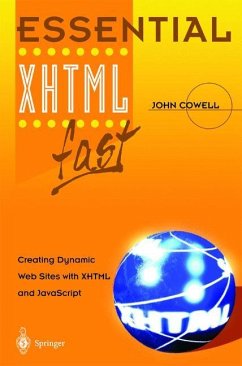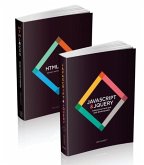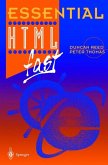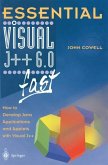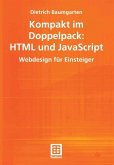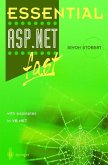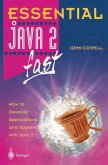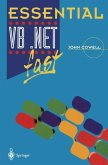XHTML is a flexible XML-based markup language for designing Web sites. In January 2000, the W3C announced that it was supporting the development of XHTML as a replacement to HTML. HTML will continue to be around for a while, but if you want to develop Web sites for the future you need to switch to XHTML. Designers who make the change find that they can develop faster, better sites using XHTML.
Most Web sites are interactive, responding to the viewer. To do this you need to use a scripting language - JavaScript is the most popular scripting language and interfaces easily with XHTML. To develop powerful interactive Web sites you need to understand these technologies and how they work together.
Essential XHTML fast gives you everything you need to develop great Web sites in XHTML, including an introduction to scripting with JavaScript so that you can create dynamic interactive Web pages. There are many step-by-step examples, which you can download from the series Web site.
It covers key aspects such as:
- The relationship between XML and XHTML
- Cascading Style sheets for formatting layout
- Using text, images and image maps as links
- Creating and using tables
- The new standard for frames
- Interactive XHTML forms
- The JavaScript language
- Incorporating JavaScript into XHTML pages
- Handling events in JavaScript
The source code for the examples in this book is available at the Essential series web site http://www.essential-series.com
Headings 34 Line breaks 35 Inserting lines 36 Colours and Fonts : 37 Settingthebackground colour 38 Settingthetextcolour 38 Setting thefont 39 Lists 39 Nesting lists 41 Definition lists 42 5. CREATING LINKS 45 Introduction 46 WhatisaURL? 46 The protocol identifier 47 The Web server 47 The folder and filename 47 The aelement 48 Absolute and relative URLs 48 Absolute URLs 48 Relative URLs 49 Server relative URLs 51 Linkswithinadocument 51 Email links 52 6. CREATING AND USING TABLES 53 Introduction 54 Creating tables 54 Formatting tables 57 Formattingcells 62 The align and valign attributes 62 The colspan and rowspan attributes 63 Grouping table elements 64 The colgroup element. . 67 Style sheets 68 7. WORKING WITH IMAGES 69 Introduction 70 Image Formats 70 GIF files 70 lPEG files 72 PNG files 72 Which format should Iuse? 73 Minimizing filesize 73 Displaying images 74 Linking from an image 75 Image maps 75 Defining Rectangles 77 Defining Circles 78 Defining Polygons 78 Definingthedefault region 78 Activating themap 79 Client and Server side maps 79 8. CASCADING STYLE SHEETS 81 Introduction 82 Typesofstyle sheets 83 Embedding astyle sheet 83 Style sheet codes 84 Linking toastyle sheet 86 Applying stylestomore than one element. . . 88 In-line formatting 89 Classes and IDs : 89 Creating and using IDs 90 Creating and using classes 91 Creating astyle sheet.
Hinweis: Dieser Artikel kann nur an eine deutsche Lieferadresse ausgeliefert werden.
Most Web sites are interactive, responding to the viewer. To do this you need to use a scripting language - JavaScript is the most popular scripting language and interfaces easily with XHTML. To develop powerful interactive Web sites you need to understand these technologies and how they work together.
Essential XHTML fast gives you everything you need to develop great Web sites in XHTML, including an introduction to scripting with JavaScript so that you can create dynamic interactive Web pages. There are many step-by-step examples, which you can download from the series Web site.
It covers key aspects such as:
- The relationship between XML and XHTML
- Cascading Style sheets for formatting layout
- Using text, images and image maps as links
- Creating and using tables
- The new standard for frames
- Interactive XHTML forms
- The JavaScript language
- Incorporating JavaScript into XHTML pages
- Handling events in JavaScript
The source code for the examples in this book is available at the Essential series web site http://www.essential-series.com
Headings 34 Line breaks 35 Inserting lines 36 Colours and Fonts : 37 Settingthebackground colour 38 Settingthetextcolour 38 Setting thefont 39 Lists 39 Nesting lists 41 Definition lists 42 5. CREATING LINKS 45 Introduction 46 WhatisaURL? 46 The protocol identifier 47 The Web server 47 The folder and filename 47 The aelement 48 Absolute and relative URLs 48 Absolute URLs 48 Relative URLs 49 Server relative URLs 51 Linkswithinadocument 51 Email links 52 6. CREATING AND USING TABLES 53 Introduction 54 Creating tables 54 Formatting tables 57 Formattingcells 62 The align and valign attributes 62 The colspan and rowspan attributes 63 Grouping table elements 64 The colgroup element. . 67 Style sheets 68 7. WORKING WITH IMAGES 69 Introduction 70 Image Formats 70 GIF files 70 lPEG files 72 PNG files 72 Which format should Iuse? 73 Minimizing filesize 73 Displaying images 74 Linking from an image 75 Image maps 75 Defining Rectangles 77 Defining Circles 78 Defining Polygons 78 Definingthedefault region 78 Activating themap 79 Client and Server side maps 79 8. CASCADING STYLE SHEETS 81 Introduction 82 Typesofstyle sheets 83 Embedding astyle sheet 83 Style sheet codes 84 Linking toastyle sheet 86 Applying stylestomore than one element. . . 88 In-line formatting 89 Classes and IDs : 89 Creating and using IDs 90 Creating and using classes 91 Creating astyle sheet.
Hinweis: Dieser Artikel kann nur an eine deutsche Lieferadresse ausgeliefert werden.

